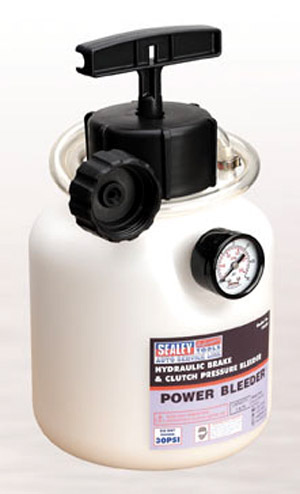Bleed the brakes
If air gets trapped inside the brake hoses a softer brake pedal is felt. The brakes need to be bled and the air removed from the system. This procedure is relatively simple, being made much easier with a specialist bleeder.
If you have air in the system (eg. when changing brake hoses) then you'll pretty much always need to mess around with the front callipers to get it all out as the design of them traps the air in the inner piston.
If it's just for flushing the system with new fluid (no air in the system) then it's pretty straightforward and you don't have to mess about with the callipers.
It helps a lot if you have spanners with a 'bend' at the end, like an open ring-spanner to keep the brake hose itself in place as you tighten the connector on the car side using a normal, but thin spanner.
On my (early) S2 there was enough space. On a VX220 I needed to dremel the hole above the connector a little to get enough clearance.
Procedure
Oh.. A small tip when changing brake hoses that can save loads of time or troubleshooting when bleeding:
- Before changing the hoses, remove the brake pads and fit very worn/old pads (or some strips of steel or wood) in their place
- Press the brake pedal a few times to extend the brake pistons in the calipers (the old pads or wedge are there to keep them from popping out completely!)
- Now disconnect an old brake hose from the car
- Disconnect the old hose from the caliper
- Connect the new hose to the caliper and tighten up
- Have a helper keep the open hose end up as high as possible
- Gently push back the piston in the caliper (hand/finger pressure for the fronts, screw back the rear) until brake fluid just comes out the open hose end
- Now connect the hose to the fixed line on the car
- Bleed caliper immediately (tap on the brake line and caliper with a plastic/wooden hammer to dislodge any tiny bubbles that are stuck on the walls)
Using this method I found that:
- You only introduce a tiny amount of air in the system (esp. on ABS equipped cars you don't want an air bubble to travel up to the hydraulic unit)
- You immediately know if you have air left in this specific part of the circuit if the brake pedal was hard beforehand, but now remains 'soft'.
Bleeders
Power bleeders
safety goggles recommended Pump up to 10psi, or 20psi... Fitted with Ø42mm cap and suitable for most European models
Eezi Bleed kit
Uses the air pressure from your tyre to force the brake fluid through.
Oh, and don't make the schoolboy error I made, when you decide that you've got all the air out then just do a one more cheeky bleed without realising that the reservoir is almost empty. Oh how you'll laugh as you shoot big globs of air into the system... :wall
Make your own with plant sprayers
use it at your own risk, but I made my own Easybleed using one of those spray can with pump included used to spray indoor plants. worked a treat (as long as there was fluid inside)
